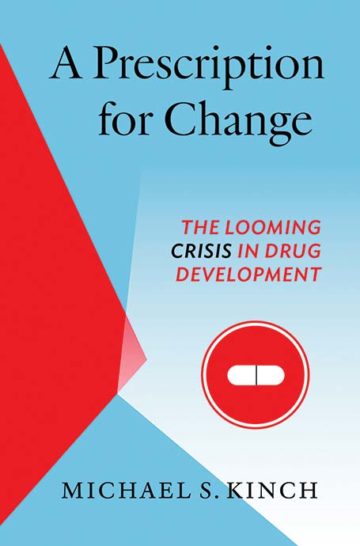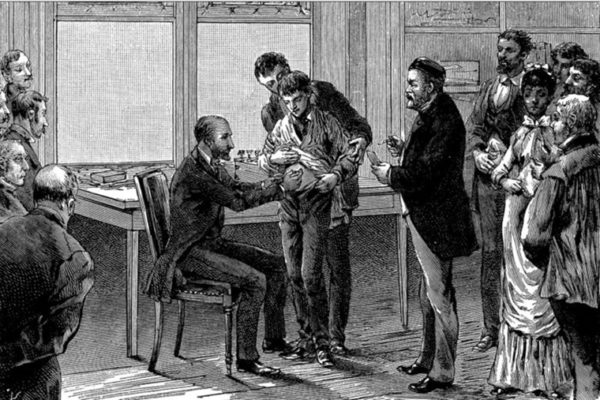Countless future theses and books will detail the dizzying pace of events in 2020. Paraphrasing an old adage, history may not repeat, but it certainly does rhyme. Pandemics are discomfortingly common but always end with two certainties: Despite great loss, our society survives and science has been strengthened by the experiences. The demonstration of mRNA-based vaccines is but one example.

A Prescription for Change
The Looming Crisis in Drug Development
As I related in my first book, A Prescription for Change, a direct line connects the scientific and medical understandings arising from the 1918 influenza pandemic with the biotechnology revolution that began 60 years later and still continues today. The world experienced a giant leap in public health that continues to improve both the quality and quantity of life for billions of people around the world. This same biotechnology revolution allowed American scientists and physicians to leapfrog to the top of the charts in terms of public health and economic impacts arising from medical advances. Academic medical centers have both contributed to and benefited from these advances. In A Prescription for Change, I show how Washington University was a dominant leader in facilitating the biotechnology revolution.
While we cannot and should never forget the tragic loss of nearly six hundred thousand American lives over the past 15 months, we have been witness to the remarkable discovery, development and distribution of vaccines that were conceived from scratch and based largely upon unproven technologies. Consider the time needed merely to identify a novel pathogen and begin the testing of vaccines meant to protect against it. This span has historically been measured in decades or centuries, with measles as the former record-holder for speed; progressing from the discovery of the virus to the start of vaccine testing in just over 10 years. In comparison, the time that elapsed from the identification of SARS-CoV-2 until the commencement of the first vaccine trial occurred in as many weeks. Just as remarkable: The clinical trials for these vaccines were executed with unprecedented efficiency, with three safe and effective vaccines authorized within a year. This achievement is one that many (including myself) felt impossible before the outbreak.
Yet all of this pales in comparison with the final outcome: Safe vaccines that block the most dangerous forms of COVID-19. These outcomes have surpassed all expectations and reflect an amazing cooperation amongst scientists, physicians and regulators all around the world. From a personal standpoint, I transitioned from merely analyzing clinical trials to being a volunteer in one. This experience conveyed a new view of our work at the Center for Research Innovation in Biotechnology (CRIB) at Washington University, which identifies the sources of scientific and medical innovation underpinning all approved and experimental medicines.
Yet our work is nowhere near completion. The rapid and widespread transmission of COVID-19 is creating new variants that will challenge and confound vaccines and treatment. Mutation is a particular specialty of viruses and SARS-CoV-2 is no exception. Given the virus had largely run amok for at least a year and a half, these variants could erode the efficiency of vaccines deployed and will likely require updated “boosters” to ensure the hot embers of COVID-19 do not flare into future and deadlier conflagrations.
This new challenge is a bit like the old arcade game, Whac-A-Mole. The more virus that is transmitted from person-to-person, the more likely it is that a new variant will arise and threaten the efficiency of the vaccines that we have been so fortunate to discover. To be clear, such changes will not cause our current vaccines to become suddenly useless. Rather, the effectiveness of these vaccines could gradually wane over the next few years. However, this is a game over which we have control. Although we all crave a return to the relative normality of 2019, we can do our part now by continuing the proven means of holding back the virus — social distancing and mask wearing and, most importantly, establishing long-lasting immunity via vaccination. By limiting the spread of SARS-CoV-2, we can limit viral mutation and will progressively eliminate viral variants that resist the vaccine. Eventually, we will achieve herd immunity (a point, when the virus ceases to circulate within our communities) and finally end the pandemic once and for all. This can be accomplished by continuing safe practices and ensuring that you and those around you are all immunized.
Beyond our immediate communities, we must all work together to increase the efficiency of vaccine distribution and uptake — both in the United States and worldwide. Such acts are not mere charity. From a selfish standpoint, when it comes to viruses, a global vaccination program will decrease the potential that vaccine-resistant variants might arise anywhere in the world and inevitably arrive at our shores at a later date. Thus, protecting others has the positive side-effect of protecting ourselves. Our tiny blue planet has never been so small or the risks so large as those posed by so-called “vaccine nationalism” (the propensity of some countries to hoard vaccines or utilize their availability as a bargaining chip).
Yet, we can rest assured that, working together, the amazing scientific and medical achievements and momentum gained since the beginning of the pandemic will not have been in vain. If we push for just a bit longer in maintaining mask wearing, social distancing and embracing vaccination, we can soon return not merely to a pre-2019 world but instead to a far healthier one. For the knowledge and experiences gained since late 2019 will undoubtedly facilitate new and equally exciting opportunities to prevent and treat future diseases. The benefits will likely allow us to even more efficiently address future pandemics and old nemeses, such as influenza. Even more promising is the likelihood that the technologies and vaccines used to develop COVID-19 vaccines might help us in the fight against other immune-responsive diseases such as cancer. Thus it seems not merely optimistic but pragmatic to expect that this pandemic, as others did before it, will improve the overall health of our society and its people.


